Coronavirus Today: What to expect on June 15
Good evening. Iâm Kiera Feldman, and itâs Friday, May 21. Hereâs the latest on whatâs happening with the coronavirus, plus ways to spend your weekend and a look at some of the weekâs best stories.
Weâve had June 15 marked on our calendars as the day California would reopen its economy, but we didnât have many details about what exactly that would mean. That even goes for those of us whoâve been following things like itâs their j-o-b.
Well, everything just got a little less TBD. Officials on Friday unveiled eagerly anticipated guidelines for a world that will look nothing like the California of the last year-plus.
Businesses will be able to serve customers without any limits on capacity or requirements for physical distancing. People who are fully vaccinated will no longer need to wear masks in most situations.
The state isnât considering an official âvaccine passportâ system to verify immunization status, said Dr. Mark Ghaly, Californiaâs health secretary. But businesses and event organizers may decide on their own to require that customers prove theyâve either been vaccinated or recently tested negative for the coronavirus.
Big, crowded indoor events will have the most stringent rules under the new plan â organizers will need to verify that attendees have been vaccinated or recently tested negative if more than 5,000 people are there.
At outdoor events with more than 10,000 people, the state will recommend, but not require, the same verification. (People who havenât been vaccinated or tested recently can still attend, as long as they wear a mask.)
If youâre like me and still a bit queasy at the thought of being around 10,000 other people, hereâs some good news: The data about so-called âbreakthrough infectionsâ after vaccination are looking better and better.
In L.A. County, the chances of becoming infected after youâre vaccinated are exceedingly rare. Out of 3.3 million fully vaccinated people, only 933 later tested positive for the coronavirus, according to Public Health Director Barbara Ferrer. Thatâs just 0.03%.
Among those breakthrough infections, 71 people had to be hospitalized, and 12 later died. Four of them had severely weakened immune systems, Ferrer noted.
âWe now have mounting proof that these vaccines really work,â she said.
By the numbers
California cases, deaths and vaccinations as of 6:12 p.m. Friday:

Track Californiaâs coronavirus spread and vaccination efforts â including the latest numbers and how they break down â with our graphics.

See the current status of Californiaâs reopening, county by county, with our tracker.
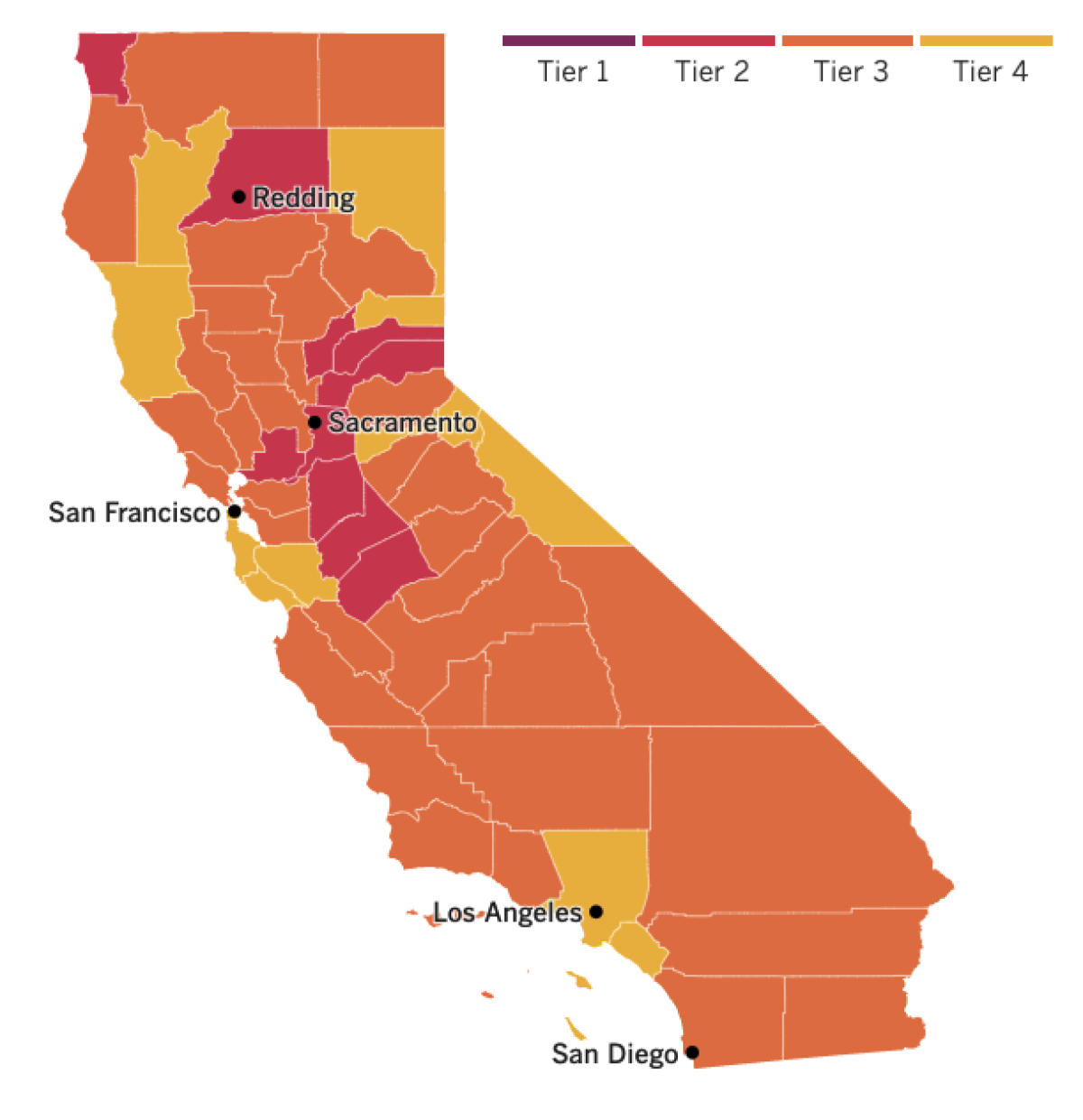

What to read this weekend
Too blue for school
For communities hit hard by the pandemic, reopening schools involves far more than rearranging desks and opening windows. My colleague Melissa Gomez brings us this story of one school district that opted to stay closed for the remainder of the year because the trauma and loss from COVID-19 were too great.
âWe canât just pick up where we left off,â said Frances Esparza, the superintendent of El Rancho Unified School District serving Pico Rivera. âSome of the students in El Rancho lost a parent, a grandparent, and some even lost both in just a few days. The staff of El Rancho Unified have also suffered the losses of family, friends and coworkers.â
High school senior Hailey Moreno lost both her father and her grandmother to COVID-19. Even logging into Zoom classes can be an emotionally wrought experience, because thatâs how she last spoke to her father.
âItâs hard. You see other kids your age ... you hear from them, and teachers, and itâs just, their lives seem so normal,â she said. âItâs not. Nothing is normal.â
Many students have needed counseling for anxiety, depression, grief and loss, and school aides and teachers will receive training to identify signs of trauma or mental health issues before summer school programs begin.
âWe need to deal with what has happened,â Esparza said.
Guinea pigs for hire
Within the first few months of the pandemic, jobs dried up in South Koreaâs restaurants, bars and supermarkets. So young people in need of cash there turned to a gig of last resort: enrolling in clinical trials, my colleague Victoria Kim reports.
Paying test subjects for the trouble and risk of swallowing, being injected with or bedaubed with drugs or other medical substances is accepted practice worldwide. In South Korea, though, clinical trials have become an easy hustle for college students, struggling freelancers and the unemployed.
âYou lie there for two nights, three days and have your blood drawn, staring at your phone, and you make money,â said Jeong Hyung-jun, a physician who is policy chair of the Korean Federation of Medical Activist Groups for Health Rights.
But some see the clinical trials as exploitative in a society that has failed to create worthwhile employment. Kim Nam-hee, a clinical professor at the Seoul National University School of Law, said the studies raise ethical questions about whether subjects are truly free to withdraw if they feel unsafe.
âItâs taking advantage of the subjectâs physical, economic vulnerability, for minimal compensation,â she said. âItâs the pharmaceutical companies that reap the benefits. Structurally, there is an ethical problem.â
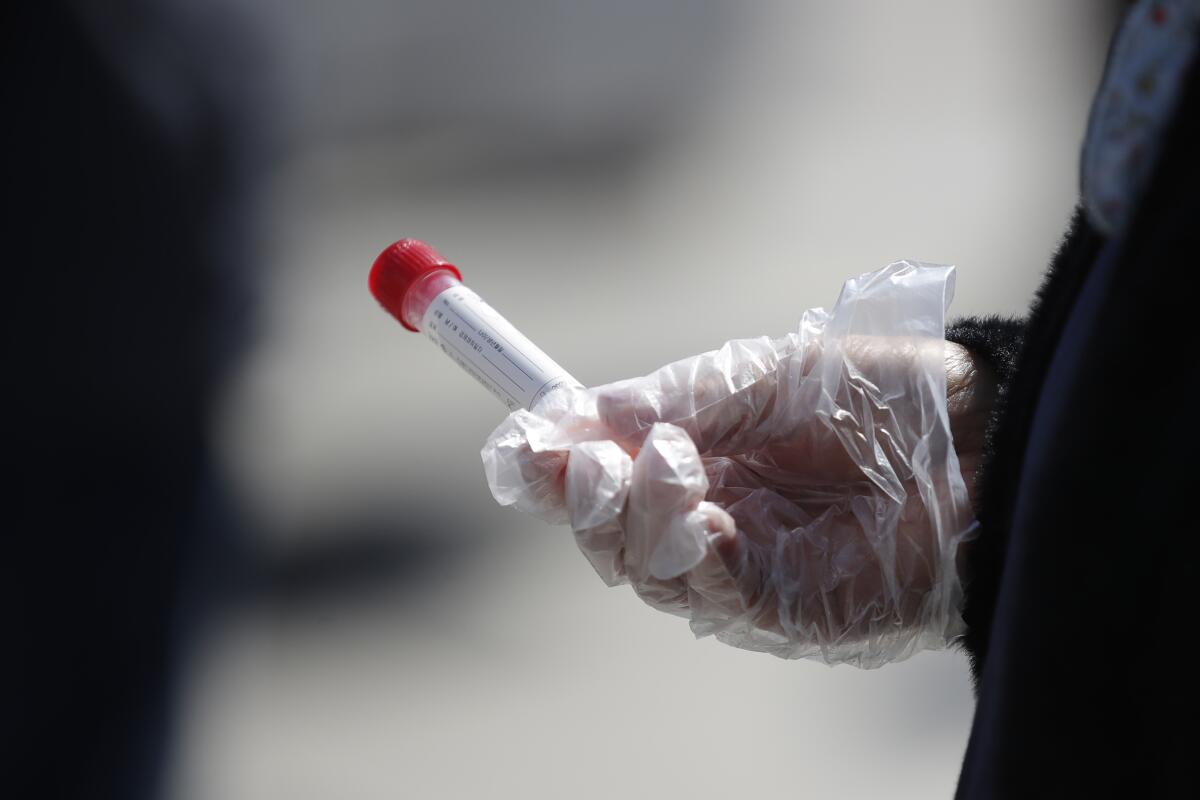
Mission not yet accomplished
California is weeks away from returning to a largely pre-pandemic life, but the âmission accomplishedâ vibe overlooks the fact that people of color are still getting left behind, columnist Erika D. Smith reminds us. And once rules about masks, social distancing and capacity limits are relaxed or removed, the gap stands to grow further.
The reason: Nearly two-thirds of Black and Latino Californians still havenât been vaccinated, and thatâs not likely to change very much by June 1, said Dr. Amon Rodgers, an assistant professor at Charles R. Drew University of Medicine and Science in South Los Angeles.
âMy concern is that the reopening happens before we get a higher rate of vaccinations in areas like Compton and South L.A.,â Rodgers said. âI donât want this community to be left holding the bag and widening the disparity that we already have.â
Like much of California, L.A. County has plenty of vaccine doses. But some people, particularly those without internet access or vehicles, still have a hard time finding a place to get the jab, Smith writes. Plus, many Black and Latino residents of South L.A. donât have a primary care physician.
âIf youâve never had access to care, you canât have a one-on-one conversation with a healthcare provider to answer your questions,â explained Dr. Roberto Vargas of Charles R. Drew University.
Mixing up the menu
Across L.A., restaurants are reopening their dining rooms, but the experience isnât necessarily the same as it was before. Many eateries have undertaken significant renovations to adhere to the rules of the yellow tier.
Marianna Caldwell, the sommelier and general manager of Cassia in Santa Monica, recalled the unsatisfying reopening last June, when the Southeast Asian restaurant had to close its doors just a week and a half after it reopened. This time around, the bar-like seafood station has been replaced with sleek, upholstered banquettes.
âWe wanted to take our time and do it right so that we wonât have to shut back down again,â she said. âAnd I donât think L.A.âs going to shut back down again.â
Restaurateursâ philosophies about reopening vary as widely as the cuisines. While some appreciated the time the pandemic gave them to reconfigure their menus and decor, others thought long and hard about how to reopen safely without straying from their roots.
That was the case for Mark Echeverria, whose family owns Musso & Frank Grill.
âFor Mussoâs, being 102 years old, it wasnât necessarily about us pivoting and trying to make something work; it was more about remaining unchanged,â he said.
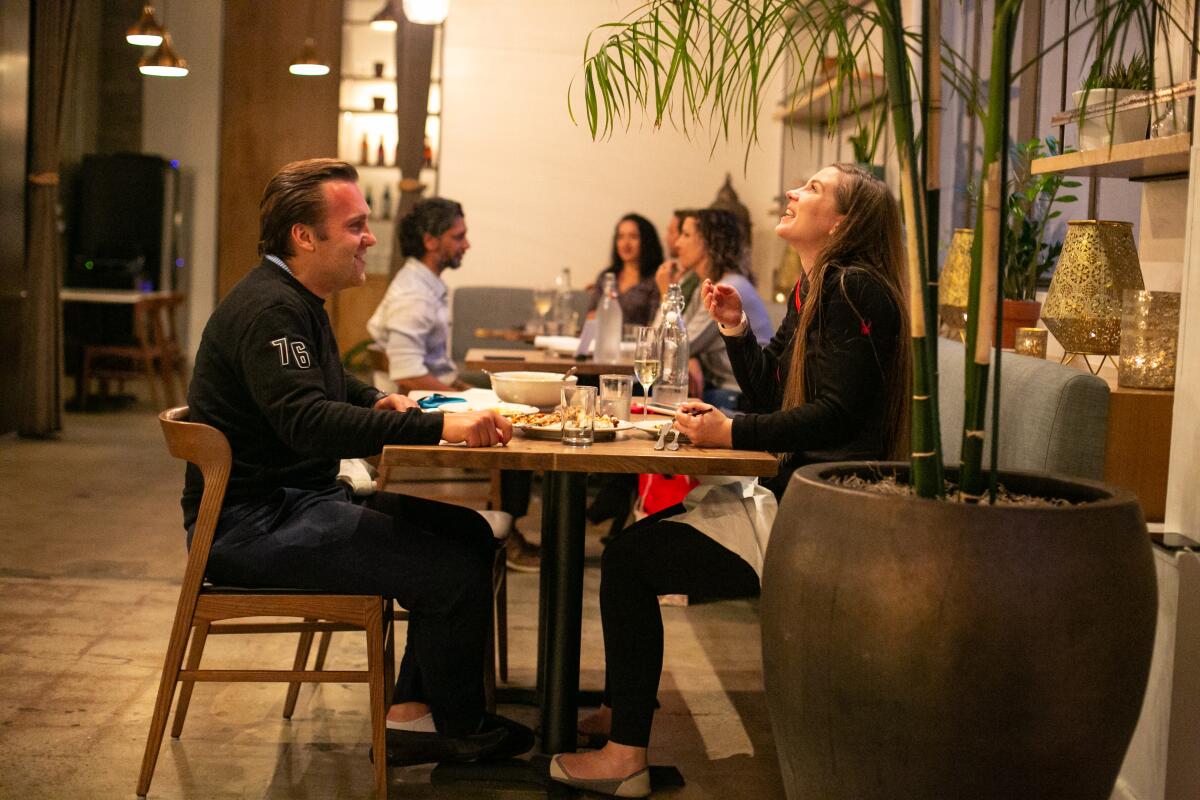
Stranded students
Many American college students have spent the pandemic zooming into classes from their childhood bedrooms. International students stuck in their home countries have faced the added hardships of time zone differences that forced them to log on for midnight classes.
Now that the coronavirus is ebbing in the U.S., these students are eager to return to their stateside campuses. But huge barriers are in their way, my colleague Teresa Watanabe reports. International students are panicked that huge backlogs for visa requests, shuttered consulates and bureaucratic rules that limit access to the U.S. may derail their long-awaited return.
UC Berkeley student Ruhi Jha began her college career remotely from her home in New Delhi. Last month, she and her family members contracted â and survived â COVID-19. The experience was terrifying, but now sheâs feeling anxious about whether sheâll be able to get to California in time for the fall term. Berkeley also requires students to get the COVID-19 vaccine, but trying to land an appointment for one in the worldâs second most populous country amid a devastating outbreak so far has been frustrating and fruitless.
âI donât think Iâve ever been in such a stressful situation in my life,â she said. âThere have been quite a few moments of tears, but you just have to stay positive and scrape through whatever life is showing you.â
Your support helps us deliver the news that matters most.
What to do this weekend
Get outside. Try a hike from our list of the 50 best hikes in L.A. Or get inspiration from South L.A. and turn your yard into a microfarm. And next week, a total lunar eclipse is happening in the early hours of Wednesday, which would be a great time to head to the newly designated dark-sky community of Julian to see the âsuper flower blood moon.â Subscribe to The Wild for more on the outdoors.
Watch something great. Our weekend culture watch list includes âMad Max: Fury Road,â âJurassic Park,â âMoanaâ and more at local theaters, pop-ups and drive-ins. And in his Indie Focus newsletterâs roundup of new movies, Mark Olsen recommends the French film âSpring Blossom.â Written, directed by and starring 19-year-old Suzanne Lindon, the film tells the story of a teenager who engages in a flirtatious, chaste relationship with a 35-year-old actor. Critics have raved about this coming-of-age narrative that reckons with the French culture of sexualizing teenage girls.
Eat something great. Feast on moles and other Oaxacan food in Koreatown at Guelaguetza, winner of the 2021 Gold Award from The Times. Or savor a 10-course tasting menu at Phenakite, named restaurant of the year by The Times. Bill Addison also recommends his favorite L.A. restaurants for outdoor dining in the latest issue of the Tasting Notes newsletter.
Go online. Hereâs The Timesâ guide to the internet for when youâre looking for information on self-care, feel like learning something new or interesting, or want to expand your entertainment horizons.
The pandemic in pictures
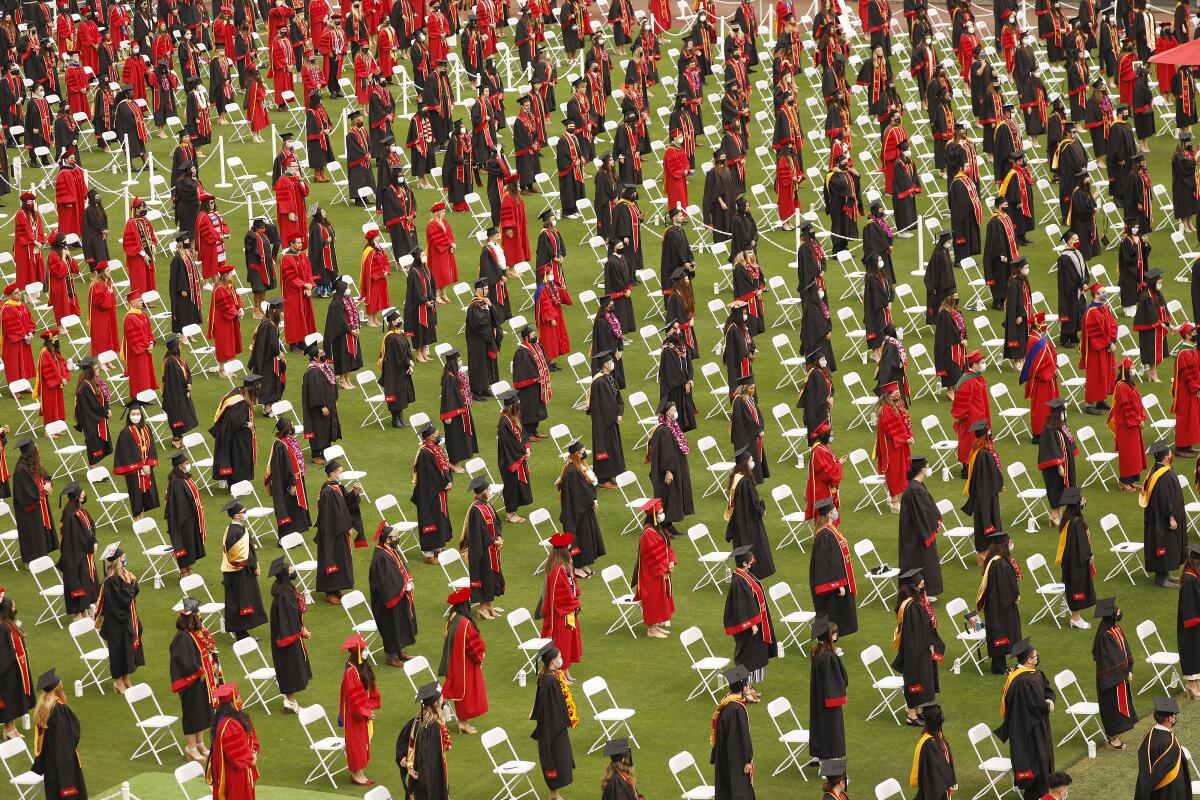
Members of USCâs Class of 2020 finally got to wear their caps and gowns â one year after they graduated.
The university held 14 different commencement ceremonies over seven days to celebrate the classes of 2020 and 2021. A total of 21,000 students took part in the ceremonies, which were held outdoors at the Los Angeles Memorial Coliseum for the first time in 71 years.
Masked students sat eight feet apart on the field, while spectators were socially distanced in the stands. Photographer Al Seib brought back a series of shots that captured the elation of the collective celebration.
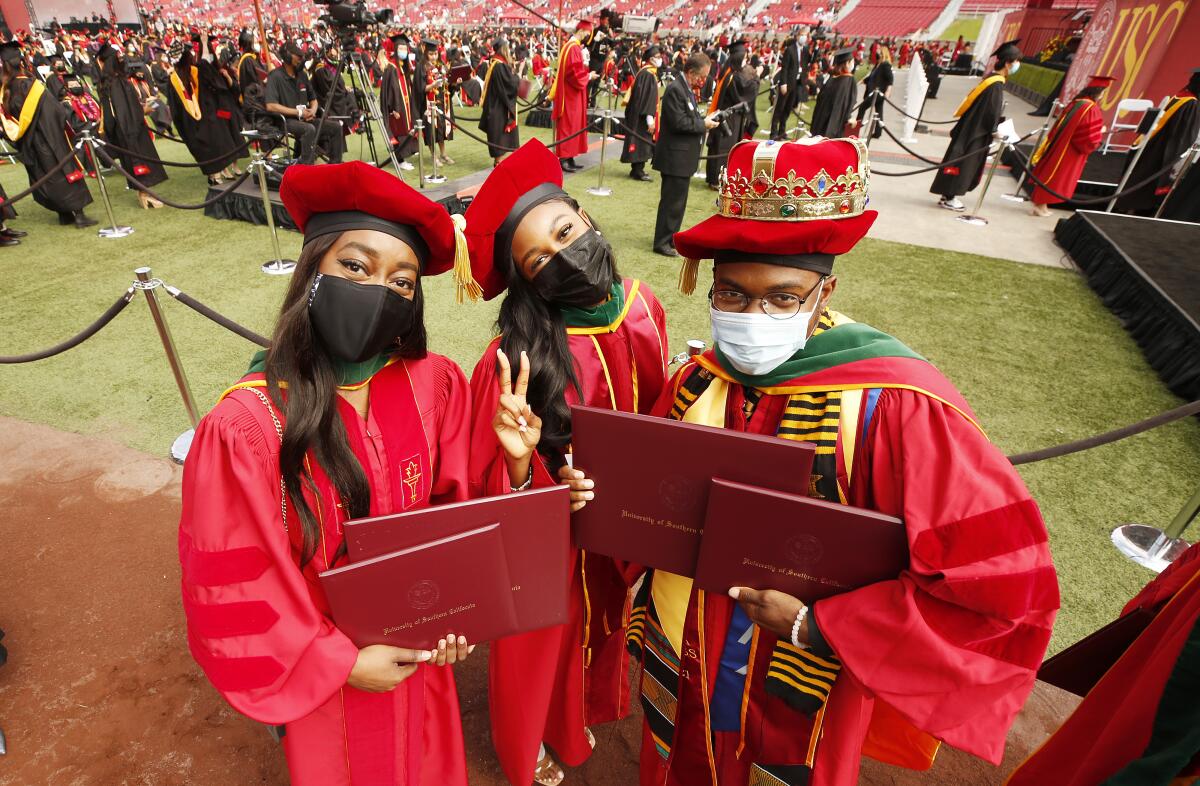
Resources
Need a vaccine? Sign up for email updates, and make an appointment where you live: City of Los Angeles | Los Angeles County | Kern County | Orange County | Riverside County | San Bernardino County | San Diego County | San Luis Obispo County | Santa Barbara County | Ventura County
Need more vaccine help? Talk to your healthcare provider. Call the stateâs COVID-19 hotline at (833) 422-4255. And consult our county-by-county guides to getting vaccinated.
Practice social distancing using these tips, and wear a mask or two.
Watch for symptoms such as fever, cough, shortness of breath, chills, shaking with chills, muscle pain, headache, sore throat and loss of taste or smell. Hereâs what to look for and when.
Need to get tested? Hereâs where you can in L.A. County and around California.
Americans are hurting in many ways. We have advice for helping kids cope, resources for people experiencing domestic abuse and a newsletter to help you make ends meet.
Weâve answered hundreds of readersâ questions. Explore them in our archive here.
For our most up-to-date coverage, visit our homepage and our Health section, get our breaking news alerts, and follow us on Twitter and Instagram.




